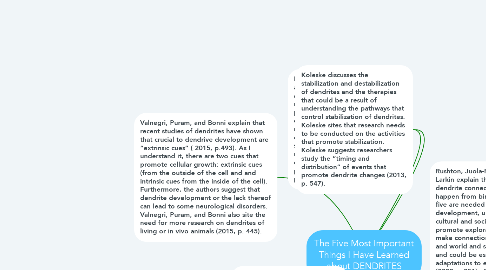The Five Most Important Things I Have Learned about DENDRITES
by Jen Foradori

1. Valnegri, Puram, and Bonni explain that recent studies of dendrites have shown that crucial to dendrive development are “extrinsic cues” ( 2015, p.493). As I understand it, there are two cues that promote cellular growth: extrinsic cues (from the outside of the cell and and intrinsic cues from the inside of the cell). Furthermore, the authors suggest that dendrite development or the lack thereof can lead to some neurological disorders. Valnegri, Puram, and Bonni also site the need for more research on dendrites of living or in vivo animals (2015, p. 445).
2. Koleske discusses the stabilization and destabilization of dendrites and the therapies that could be a result of understanding the pathways that control stabilization of dendrites. Koleske sites that research needs to be conducted on the activities that promote stabilization. Koleske suggests researchers study the “timing and distribution” of events that promote dendrite changes (2013, p. 547).
3. Stuart and Spruston begin their history of dendrite research with a definition: a receiving element of a neuron, the “dendritic tree” is what enables neurons to interpret the information they receive, as I understand it (2015, p. 1713). Dendrites, discovered in 1889 by Santiago Ramon y Cajal, were not widely researched until the 1950s. Stuart and Spruston write that due to 60 years of research scholars now know that dendrites are essential in “information processing” (2015, p. 1718). The authors suggest that in the future research is needed on in vitro dendrite development and in vivo, meaning on live, born subjects; this need for in vitro and in vivo research is also mentioned in the article by Valnegri, Puram, and Bonni as well as in the article by Ziegler and Tavosanis. ¶
4. Koleske discusses the stabilization and destabilization of dendrites and the therapies that could be a result of understanding the pathways that control stabilization of dendrites. Koleske sites that research needs to be conducted on the activities that promote stabilization. Koleske suggests researchers study the “timing and distribution” of events that promote dendrite changes (2013, p. 547).
5. Rushton, Juola-Rushton and Larkin explain that the rapid dendrite connections that happen from birth to the age of five are needed for language development, understanding cultural and social norms, promote exploration and play, to make connections between self and world and self and others, and could be essential for adaptations to environments (2009, p.351). Rushton, Juola-Rushton and Larkin urge educators to be aware that a child cannot perform a task just because the teacher wants them to, but that child needs to be met where they in dendrite formation, meaning the child may not be wired to perform that task yet. Rushton, Juola-Rushton and Larkin call for dendrite research that can help close the gap between what we want a child to be able to do and what they can reasonably do (2009, p. 359).
6. Ziegler and Tavosanis explain the importance of lipids (fatty acids) in dendrite development, and call for research of lipids and their relation to dendrite malfunctions that lead to neurological disorders (2018, p. 8). The authors also call for research on live, in vivo subjects.


